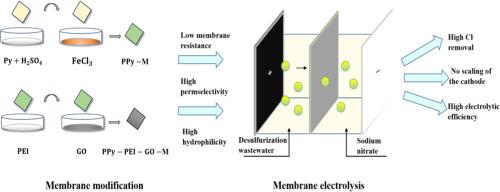Enhanced anion exchange membranes for efficient chlorine removal via polypyrrole, polyethyleneimine, and graphene oxide Co-deposition
IF 5.7
3区 材料科学
Q2 MATERIALS SCIENCE, MULTIDISCIPLINARY
引用次数: 0
Abstract
Anion exchange membranes polypyrrole-modified(PPy-M), polypyrrole-graphene oxide-modified(PPy-GO-M), and polypyrrole-polyethyleneimine-graphene oxide-modified(PPy-PEI-GO-M) were synthesized using in situ polymerization for advanced desulfurization wastewater treatment and cathodic scaling inhibition in membrane electrolysis(ME). Characterization by SEM-EDX(scanning electron microscope-energy-dispersive X-ray spectroscopy), AFM(Atomic force microscopy), FT-IR(Fourier-transform micro-infrared spectrometer), XPS(X-ray photoelectron spectroscopy), and Raman spectroscopy revealed the membranes morphology and chemical properties, and their basic performances, including ion exchange capacity, water uptake, contact angle, zeta potential,perm-selectivity, and the membrane resistance, were rough analyzed. PPy-PEI-GO-M showed the best performance, with an ion exchange capacity of 2.57 mmol g-1, contact angle of 85°, zeta potential of +15.59 mV, membrane resistance of 6.97 Ω cm2, and perm-selectivity of 98 %. Under optimal electrolysis conditions (ME time 180 min, temperature 30 °C, current density 40 mA cm-2, electrode spacing 4 cm), it achieved a Cl- removal rate of 96.83 % without cathodic scaling, with treated effluent successfully reused in a flue gas desulfurization system. This modified membrane shows strong potential for water treatment applications.

通过聚吡咯、聚乙烯亚胺和氧化石墨烯共沉积增强阴离子交换膜的高效氯去除
采用原位聚合法制备了聚吡咯-改性(PPy-M)、聚吡咯-氧化石墨烯改性(PPy-GO-M)和聚吡咯-聚亚胺-氧化石墨烯改性(PPy-PEI-GO-M)阴离子交换膜,用于膜电解(ME)中深度脱硫废水的处理和阴极阻垢。利用SEM-EDX(扫描电子显微镜-能量色散x射线能谱)、AFM(原子力显微镜)、FT-IR(傅里叶变换微红外光谱仪)、XPS(x射线光电子能谱)和拉曼光谱对膜的形貌和化学性质进行了表征,并对膜的离子交换容量、吸水率、接触角、zeta电位、热选择性和膜电阻等基本性能进行了初步分析。PPy-PEI-GO-M表现最佳,离子交换容量为2.57 mmol g-1,接触角为85°,zeta电位为+15.59 mV,膜电阻为6.97 Ω cm2,膜选择性为98%。在最佳电解条件下(电解时间180 min,温度30℃,电流密度40 mA cm-2,电极间距4 cm),无阴极结垢的Cl-去除率为96.83%,处理后的出水成功回用于烟气脱硫系统。这种改性膜在水处理方面具有很强的应用潜力。
本文章由计算机程序翻译,如有差异,请以英文原文为准。
求助全文
约1分钟内获得全文
求助全文
来源期刊

Materials Research Bulletin
工程技术-材料科学:综合
CiteScore
9.80
自引率
5.60%
发文量
372
审稿时长
42 days
期刊介绍:
Materials Research Bulletin is an international journal reporting high-impact research on processing-structure-property relationships in functional materials and nanomaterials with interesting electronic, magnetic, optical, thermal, mechanical or catalytic properties. Papers purely on thermodynamics or theoretical calculations (e.g., density functional theory) do not fall within the scope of the journal unless they also demonstrate a clear link to physical properties. Topics covered include functional materials (e.g., dielectrics, pyroelectrics, piezoelectrics, ferroelectrics, relaxors, thermoelectrics, etc.); electrochemistry and solid-state ionics (e.g., photovoltaics, batteries, sensors, and fuel cells); nanomaterials, graphene, and nanocomposites; luminescence and photocatalysis; crystal-structure and defect-structure analysis; novel electronics; non-crystalline solids; flexible electronics; protein-material interactions; and polymeric ion-exchange membranes.
 求助内容:
求助内容: 应助结果提醒方式:
应助结果提醒方式:


